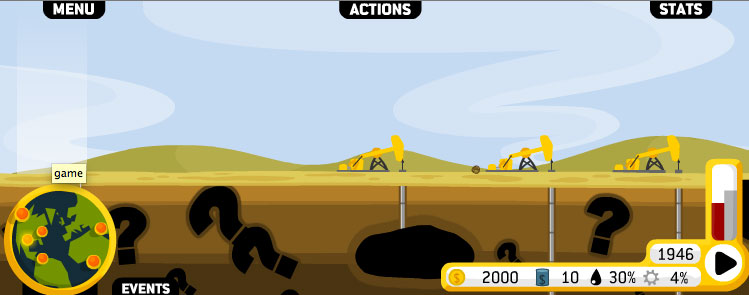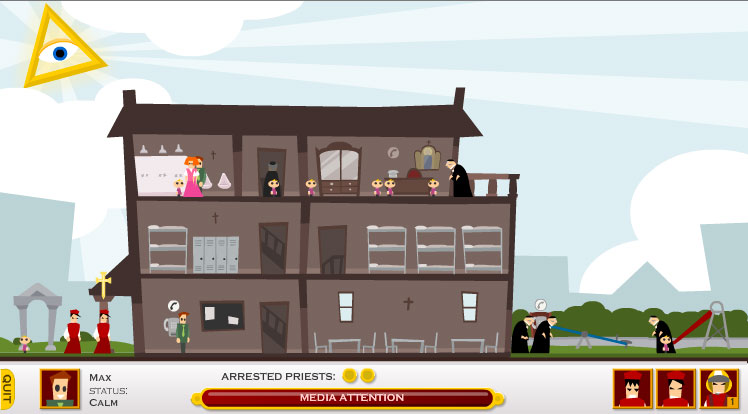Interns Jonathan and Joshua return once more with some random game testing.
Last week, we forgot to mention that we were able to play-test Mark Essen’s prototype Pachinko game. In the current state of the game, it’s very generic aesthetically, but the systems involved that make the game what it is work perfectly fine. Much like how one would chance his luck on the slots of Vegas, Essen’s Pachinko game functions almost entirely alike. The player initially starts with 25 credits, and every play always deducts 5 credits from the player. There are three slot reels that rapidly spin downwards, which seemingly get progressively faster up to a certain point if the player takes too long to cast a reel. Clicking on the screen causes a reel to stop, beginning from left, to middle, to right. Pictures on each of the reels denote the possible credit score if the player manages to get two or three in a row. If the player achieves two or three in a row, a payout is given, causing a stream of coins to pour from the mouth of the machine. Stubs, which actively move around until all three rolls have been cast, will cause falling coins to bounce off in a different direction, and may possibly cause them to hit the floating 2x multiplier box near the bottom of the screen. Coins that fall into the box are worth 2 credits, while those that don’t are worth 1 credit. The game ends when the player is unable to pay the 5 credits needed to play again. However, pressing the ‘M’ key will award the player with 25 coins if needed, serving as a reset after losing.
And just recently, we tried out this other game under the title ‘Voxatron’, a 3D shooting game using models constructed out of small 1×1 dimension cubes, similar to that of Minecraft or your typical Lego products. Actually, you could imagine a shooting game made out of Legos. With robots and weird creatures. For being constructed out of cubic primitives, it is aesthetically appealing and easy on the eyes. It has a tilted HUD to give perspective of the digital spaces, allowing you to see that it’s clearly 3D even though the models would seem to derive from a 2D aspect. Space is to jump, directional arrow keys to move, and X or C is to shoot. Holding the shoot button also locks your direction, so you are able to strafe, backpedal and proceed as you shoot on the move. Fortunately, unlike in some games, backpedaling does not penalize you in any way since all movements are treated as moving forward in the desired direction.
Perhaps the most difficult aspect of the game to control for us was the key mapping of the in-game character. Because movement is based on the directional arrow keys, which for most boards are towards the right, and shoot is mapped to the X and C keys, it can handicap players who are used to using the WASD keys for movement, due to the location of the keys. This causes a hindrance of in-game performance with the unfamiliarity of the mapping.
That’s all there is for now. We’ll be returning to work on the final project based on Pachinko once again.
In the past few days, we’ve spent time observing scripts in C# and JavaScript, learning about some of the basic albeit keystone terminology utilized in scripting languages. Below are a few of the terms covered for the week.
Int; short for integer.
Float; a non-whole number, a decimal.
String; an object, may contain characters.
Var; short for variable, can contain data.
Array; a list, can contain data.
Flow of control; order of command execution.
If/Then/Else; conditional statement, leading to ‘something’.
Operators; mathematical operation signs and symbols (e.g. ==, >=, ect.)
We’re beginning to delve into Processing as well, an open source language specializing in image creation, so that we can further understand scripting in general. Practice began by drawing examples from the program itself and analyzing the code imbedded in each instance. We were asked to create a maze-based game through Processing, but ran out of time through practice before we could get any work on it. A working project of it may be finished by next week, and will be included in the next upcoming week.
Game Lab interns Joshua and Jonathan back for week 2 with a confirmed concept to work with. The basic idea is to create a functional game that primarily utilizes physics due to its simplicity of implementation. Included in this post is an array of image references and a rough demonstrative model.
Read more on “Internship Week 2 – Beginning Development” »
March 13, 2012 at 6pm
UCLA Broad Art Center EDA
Paolo Pedercini will present Molleindustria, a project exploring the intersection of ideology and electronic entertainment. Since 2003 Molleindustria released experimental video games dealing with unusual themes such as sex, religion, labor and ecology.
Sponsored by the UCLA Game Lab
Parking directions: http://dma.ucla.edu/information/directions/





Game Lab interns Jonathan and Joshua here this week, and a couple things have changed since the previous year. We’ll begin with a little new and re-introduction.
Jonathan: I’m a returning Game Lab intern for round two, and this time I’m looking forward to working on something, anything that would be a step up from the previous year. I don’t have any exact plans on the end project which will be a game created through Unity and Maya, so anything for the most part is up for discussion between me and Joshua.
Joshua: I am a new intern here at the Game Lab, and I was previously interning in a research lab also in UCLA. I’m looking forward to learning some new things, and excited to learn to use these programs. Hopefully Jonathan and I will be able to make a great game and learn a lot about Unity and Maya.
Former intern Justin will not be here this time around due to personal aspirations. Joshua will take his place for the current term.
To start off the first week, we have been spending time watching tutorials on using Maya to get a feel for the UI and modelling. We know that Maya in general takes years to master, but we should have, by the time the internship is over, learned a couple of tricks here and there and have the skill required to generate a prototype game. There is no consensus as of now for what the game will be, but within the next few weeks, there should be a confirmed concept to work on.





